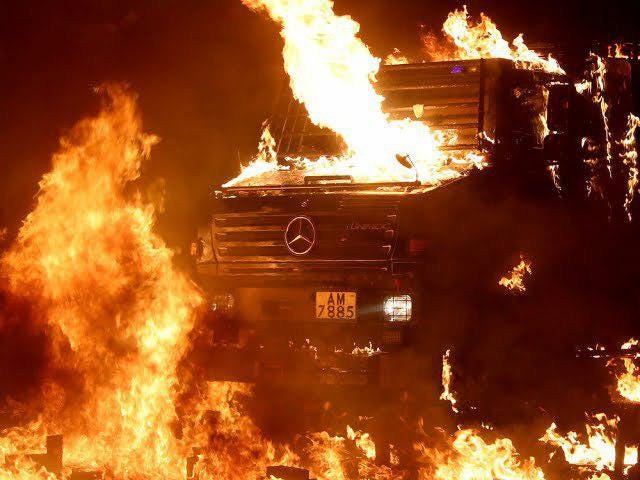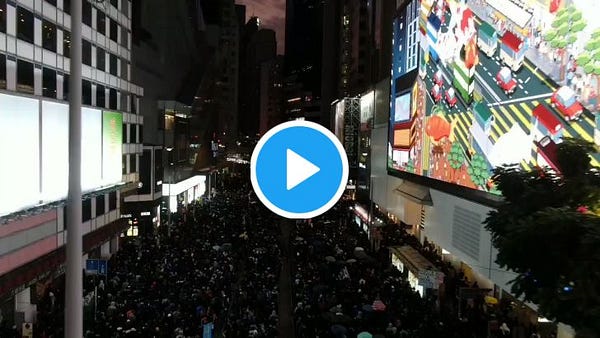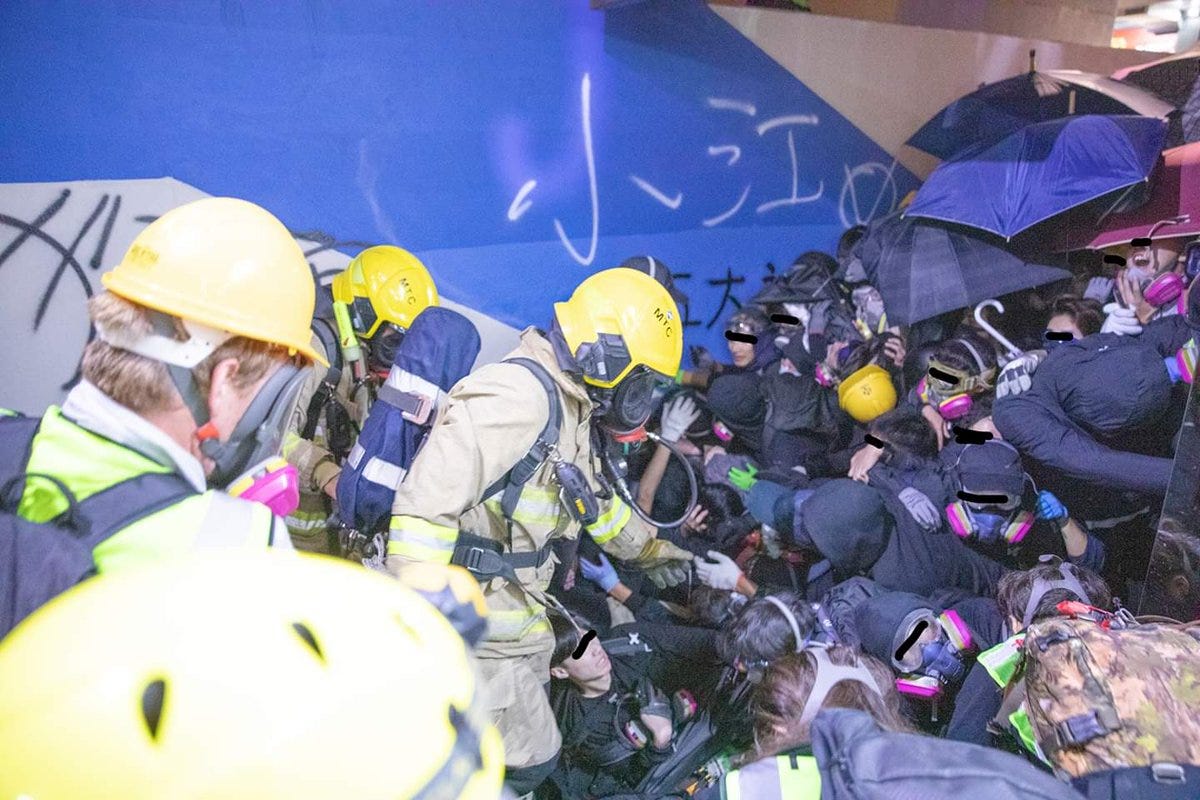
Something changed, but no one knows quite what happened. Things are ‘quiet’ in the sense that we just had a march that equaled, or exceeded, the headcount for the 2003 anti-Article 23 protests that ended with the law being shelved and our first Chief Executive fired a few months later. What made it ‘quiet’ was that police only pepper-sprayed people instead of gassing another authorized march as they had a week earlier.
It was also quiet because, unlike November 18th, entire sidewalks weren’t ripped up for bricks, and the streets weren’t literally on fire from “napalm-ish” Molotovs. Let me state at the outset that I don’t think this movement is over - far from it. I know what the end of 2014’s Umbrella Movement felt like, and this isn’t it. Instead, it feels like things are transitioning into a new phase, or perhaps the movement is taking something like a restive nap.


Recap of the Siege of PolyU and Kowloon Uprising
I should recap what happened on November 18th. In short, it was by far the most insane day of this entire movement. It started on November 17th when police laid siege to Hong Kong Polytechnic University (PolyU). A week after CUHK, they showed up unwilling to retreat this time. They came out with MP-5’s, AR-15’s, SIG516’s for the first time. There were snipers on the roof of a nearby hotel. At some indeterminate point that night, police sealed the campus off entirely. An HKPF Unimog was ablaze during the assault over a bridge over the Cross-Harbour Tunnel. It wasn’t until the next morning that the people inside PolyU (of which only half of the protesters were students) realized they were trapped.
Starting at around noon, and then picking up substantially in the evening, there was essentially a district-wide uprising to reach PolyU and break the police siege. In other words, the plan was to approach the campus from multiple directions to break through police cordon lines with fire and bricks. There was, at one point, a human chain with middle-class professional types passing kerosene to the frontline and they got within 300 meters before turning back. Several Unimogs and a water cannon were temporarily taken out of action with flat tires and [likely] broken axles.
We don’t have exact numbers, but something like 1200-1400 people were arrested in those two days (including first aiders and freelance journalists). There were several attempts to break out of PolyU, one of which involved about a hundred people running into an unseen water cannon. Three hundred fifty-four people were injured, including someone listed as “<1 year old.” Among the injured were more than 30 protesters sent to hospitals after a stampede and eight-person deep crush in Yau Ma Tei. OSINT HK has spent weeks reconstructing this horrific incident that police still deny happened. Among other incidents were almost a dozen people tied up on a Tsim Sha Tsui rooftop at 4 am. Someone inside HKPF leaked a video, but we have no idea what happened or why they were on a roof.

Why Did it Go Quiet After 11/18?
And then… almost nothing happened for two weeks. As I wrote at the time, “this simply isn’t sustainable.” It wasn’t.
The calm was part of a temporary ‘ceasefire’ or truce to deprive the Hong Kong government of any reason to cancel the District Council elections on the weekend after PolyU. It was followed by opposition candidates winning in a landslide flipping seats across Hong Kong. The DAB hadn’t been meaningfully challenged in a District Council race in almost a decade where I live, but this time their candidate won by just over thirty votes. Many people wanted to savor a ‘win’ for as long as possible before gearing back up in masks and balaclavas.



This was followed by two authorized marches, both of which were peaceful until one was [accidentally?] tear-gassed. I find myself rotating competing theories for this relative calm in my head. At first, it just felt like everyone was just exhausted, especially after the insane first half of November. Both the police and protesters seemed to need a break, and everyone seems to enjoy the ‘normality’ of schools being re-opened and not being worried about getting caught in HKPF crossfire.
A theory I’m not persuaded to yet is that the police more-or-less achieved their goal at PolyU. The reason for the weeks-long siege was that they believed they had hundreds, if not thousands, of the most ‘hardcore’ frontliners surrounded and could wait them out to surrender. The government and police always assumed they could mass arrest their way out of this, back when they thought 1500-2000 was the magic number. Now they have nearly 6,000.
It’s difficult to reconcile this theory that the protests are running out of frontliners because so many were caught at PolyU with the pyrotechnic scenes outside PolyU the day after the siege began. Yet six thousand arrests have undoubtedly taken a cumulative toll on the movement. So too have the uncounted injuries, some quite severe, treated in the Hidden Clinic network.
At the same time, this would be the second or third frontline replacement cycle. September 1st seems to have been a critical date for when a significant number of the June through August frontliners got caught with ‘gear’ in police search cordons throughout the city during the escape from the airport. We started seeing a lot more teenagers on the frontline after that. Now they’re mostly older.
The theory that fits mine and other’s observation the most, however, is that we’re witnessing a deliberate de-escalation by HKPF. It started just before the District Council elections when police suddenly became chatty during the ‘Lunch With You’ flashmobs in Central instead of clubbing people over the head or gassing the financial district again. Then they stopped issuing letters of objection and started allowing massive marches again after months of banning them. It seems pretty clear that the new Commissioner of HKPF has given something of a de-escalation order.
There are a few reasons why that might be the case. First, they’ve successfully broken the ‘outrage cycles’ that kept fueling this movement. It's not that widespread and deeply felt anger has abated - far from it - but they’ve stopped providing new reasons every week to hit the streets and throw bricks and molotovs at them. Another possible explanation is that he’s trying to re-establish a chain of command discipline over a police force his predecessor transformed into a lawless feral paramilitary. There’s evidence that the Battle of CUHK was the work of rogue officers. It also seems Special Divisions Unit distributed assault rifles to PTU and STS on November 18-19th against orders.
A third reason is that I think HKPF was already scared of the public, but November 18th terrified them. They had been fortifying their police stations against bricks before the southern half of the Kowloon Peninsula was turned into an urban battlefield. I say ‘we’ collectively despite rarely being more than an observer, but after six months of tit-for-tat escalation, we’ve brought HKPF to a stalemate.
I think they’ve wisely concluded they can’t put this movement down with live ammo without risking being burned alive in police vans.
With every frontline officer now issued a shotgun or riot gun, they’re running out of tactical ‘less-than-lethal’ options. Strategically, they have tried everything: ‘strategic incapacitation’ by shutting the entire MTR network down several times; ‘command and control’ via injunctions, public assembly bans, and anti-mask fiats struck down by courts; escalation of force that led to an uprising. As if trying to return to the mid-June status quo, now they’re back to ‘negotiated management’ by working with organizers to find acceptable march routes.
In Search of a Metaphor
A recent Steven Vines opinion piece makes me think that there might be something bigger afoot. Vines argued that DAB leader Starry Lee’s very public (and scathing) critique of Lam’s performance was ‘writing on the wall’ that Lam’s days as Chief Executive are numbered. This view aligns with my thinking since June that Beijing would ditch Lam as soon as things ‘quieted down.’ No matter how poorly she was performing or reasonable the demands, Beijing’s recent modus operandi in Hong Kong (and nearly everywhere else) is to never back down under pressure.
For more than a month, I’ve tried to think of the right metaphor to explain how protesters have used this to their advantage as an unspoken reason for keeping protests going. The profane version goes like this: Beijing is holding a radioactive bag of dog shit. Another metaphor might be having a terrible hand at the poker table, refusing to fold, putting more chips on the table, and bluffing a losing hand until the other player folds. While less profane, the problem with the poker analogy is that this isn’t a zero-sum game with clear winners and losers at the end.
The ‘bag of dogshit’ is their HK Chief Executive whose approval numbers keep dropping to the point of nearly scraping the floor, embrace of police brutality, continued propping up of failed politicians, and degradation of their diplomacy and propaganda. All of which couldn’t be less popular with most Hong Kongers, so much so that even office workers in Central were coming out to be gassed in solidarity with teenagers throwing molotovs on MTR train tracks at the same time. It’s ‘radioactive’ because it’s worse for them the longer they’re forced to hold this baggage.
This has been a terrible look for them on the international stage too. The Hong Kong Human Rights and Democracy Act would have died [another] quiet death had they resolved Hong Kong earlier. Instead, it passed with near-unanimous bipartisan support, and the State Department recently announced that Global Magninsky Act sanctions for human rights abuses in Xinjiang. Campuses and cities around the world have now seen toxic Chinese nationalism first-hand. Chinese influence and espionage operations are getting renewed attention as well. The trajectory was all there before June, but Hong Kong’s protests and the ensuing crackdown lit the fuse.
I’ve long said that the “if we burn, you burn with us” chant should be taken both literally and seriously. I now think it had two meanings, only one of which was a pyrotechnic escalation on the protester side. The other meaning was more general: trying to crush this movement by brute force was going to be made extremely painful for all involved. It wasn’t just Bank of China branch offices that got trashed when you take stock of how much the world’s image of China has changed in the last six months.
Connecting the Dots [or Dreaming]
I find it tempting to think that the police de-escalation order might have come from very high up, to give Beijing a month or two of ‘quiet’ to marginally pivot and get on with a long-delayed rolling of heads. Lam’s isn’t the only head that needs to roll. Wang Zhimin’s Liaison Office had one job in Hong Kong - getting Beijing’s candidates into elected office, marginalize the opposition, and provide reliable intelligence to Beijing. He couldn’t have failed worse.
I only half-joke that Lam would have been jailed on fabricated charges in June had she failed this badly in a Mainland city. The only reason Lam, her Executive Council, and Hong Kong-Macau Affairs Office leadership still have their jobs is ‘face’ and a juvenile conception of power. This entire thing started because the people responsible for all this thought it would make them look 'weak’ (and send the wrong message) to back down in the face of massive public opposition.
Whatever the moral hazard risks were in June are trivial compared to backing down after turning a once boring city so upside down that kindergartens were closed for a week and a half. I don’t expect meaningful concessions soon. Still, I wouldn’t be surprised if they used this period of relative calm to fold their hand of current leadership to come back for Round II with a new deck that’s slightly less radioactive and embarrassing.
I’d act fast if this is actually their plan. Things can blow up again any minute.


